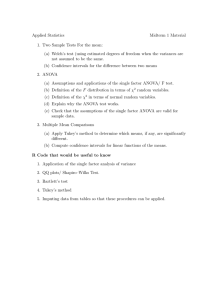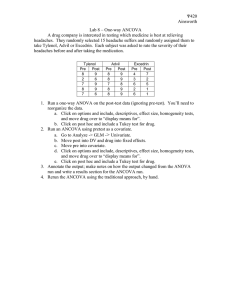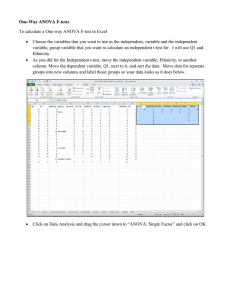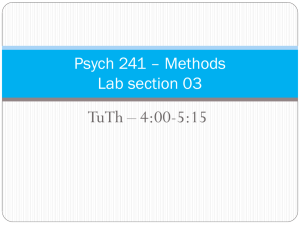732A35 1
advertisement
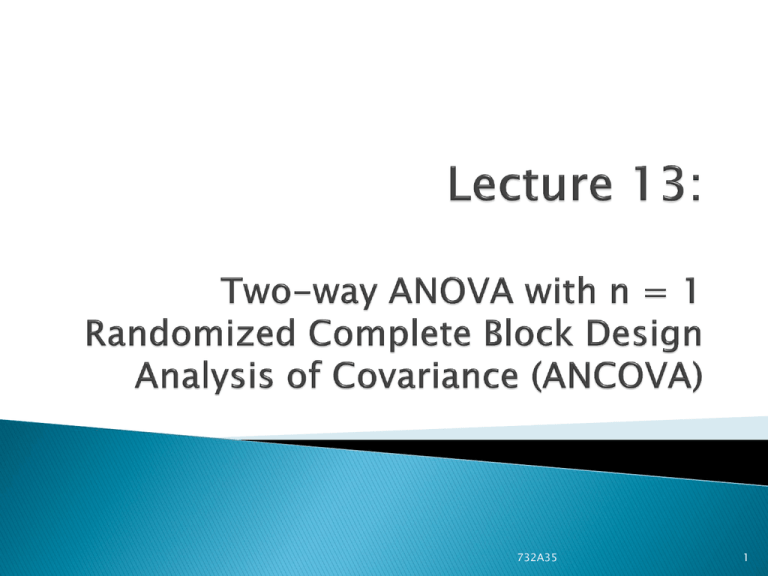
732A35 1 Constraints on cost, time etc. may sometimes limit the number of observations. And in some cases, the response variable may only be observed one time for each treatment. This (can) lead to a two-way ANOVA with only one observation per cell. 732A35 2 One problem when n = 1 is that: 𝑆𝑆𝐸 = 𝑌𝑖𝑗𝑘 − 𝑌𝑖𝑗∙ 2 =0 Therefore, we assume that there are no interaction in the model (or use transformation to make the interaction unimportant). Then: 𝐸 𝑀𝑆𝐴𝐵 = 𝜎 2 732A35 3 When testing for factor effects, MSE is replaced with MSAB. Factor A effect 𝐹∗ 𝑀𝑆𝐴 = 𝑀𝑆𝐴𝐵 Factor B effect 𝐹∗ 𝑀𝑆𝐵 = 𝑀𝑆𝐴𝐵 Note that the degrees of freedom for 𝐹𝛼 now is: a-1, (a-1)(b-1) or b-1, (a-1)(b-1). 732A35 4 Comparing the factor level means (𝑌𝑖∙∙ , 𝑌∙𝑗∙ ) is the same as earlier, just replace MSE with MSAB and modify the degrees of freedom. The treatment (cell) means (𝜇𝑖𝑗 ) is now estimated by: 𝜇𝑖𝑗 = 𝑌𝑖∙∙ + 𝑌𝑗∙∙ − 𝑌∙∙∙ 732A35 5 This is a special case of two-way ANOVA. Instead of two factors, we have: One treatment variable: The factor we want to analyze One blocking variable A factor that can affect the effect of the treatment variable This blocking will lead to a better precision in the results. 732A35 6 In this course, we study only the case when n = 1 (one replicate per cell). We assume that there are no interaction between the blocking variable and the treatment, which give us the following model: 𝑌𝑖𝑗 = 𝜇∙∙ + 𝜌𝑖 + 𝜏𝑗 + 𝜀𝑖𝑗 732A35 7 The sum of squares are having different notations compared to ”usual” ANOVA: 𝑆𝑆𝐵𝐿 = 𝑟 𝑆𝑆𝑇𝑅 = 𝑛𝑏 𝑆𝑆𝐵𝐿. 𝑇𝑅 = 𝑌𝑖∙ − 𝑌∙∙ 2 𝑌∙𝑗 − 𝑌∙∙ 𝑌𝑖𝑗 − 𝑌𝑖∙ − 𝑌∙𝑗 + 𝑌∙∙ 2 2 = 732A35 2 𝑒𝑖𝑗 8 The usual F-test is used: 𝐹∗ 𝑀𝑆𝑇𝑅 𝑆𝑆𝑇𝑅 𝑟 − 1 = = 𝑀𝑆𝐵𝐿. 𝑇𝑅 𝑆𝑆𝐵𝐿. 𝑇𝑅 (𝑛𝑏 − 1)(𝑟 − 1) Intervals can be created in the usual manner, but with replacing MSE with MSBL.TR (see page 904). Don’t forget to modify the degrees of freedom. Block effects can also be analyzed, see page 900. 732A35 9 ANCOVA can be seen as a combination of ANOVA and regression. The basic idea is to add quantitative variables that can be related to the response variable, which will lead to a higher precision in the analysis. We will only discuss one-way ANOVA with one added covariate. 732A35 10 The model for ANCOVA is: 𝑌𝑖𝑗 = 𝜇∙ + 𝜏𝑖 + 𝛾 𝑋𝑖𝑗 − 𝑋𝑖𝑗 + 𝜀𝑖𝑗 The slope (𝛾) is assumed to be the same for all factor levels, (no interaction between the factor and the covariates). 732A35 11 When testing for treatment (factor) effects, the partial F-test is used. The full model is the model with both treatment effect and covariate. The reduced model is the model with only covariate. 𝐹∗ 𝑆𝑆𝐸 𝑅 − 𝑆𝑆𝐸(𝐹) 𝑆𝑆𝐸(𝐹) = 𝑛 𝑇 − 2 − [𝑛 𝑇 − 𝑟 + 1 ] 𝑛 𝑇 − (𝑟 + 1) 732A35 12 As usual, pairwise comparisons can be calculated. But, in this case we only use Bonferroni or Scheffé. When calculating these pairwise comparisons, the fact that: 𝜏𝑖 = 0 is used. 732A35 13 Ch. 20.1 Ch. 21.1 – 21.5 (not Tukey test for additivity Ch. 22.1 – 22.3 732A35 14
